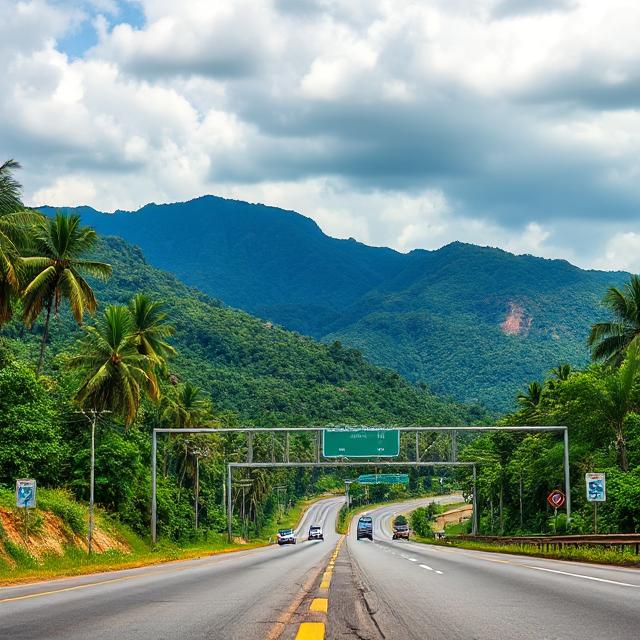Table of Contents
For a certain kind of expat or investor, the idea of a simple flight to Panama just won’t do. They are drawn to the ultimate journey, a continent-spanning road trip down the Pan-American Highway. This is not just a drive; it’s an immersive experience that allows you to see the real landscape of Central America and, more importantly, to personally vet the environment, infrastructure, and culture of the region you are considering for a major investment.
So, can you drive to Panama from the United States? The short answer is yes, with one critical and unavoidable exception. The journey is a logistical puzzle that requires meticulous planning, but it is entirely possible and can provide an invaluable perspective on your future home. This guide will walk you through the reality of this epic journey, focusing on the details that matter most to a long-term resident or real estate investor.

The Route: Following the Pan-American Highway
The Pan-American Highway is the fabled road network that, with the exception of one small break, connects North and South America. From the U.S. border, the journey takes you through Mexico, Guatemala, El Salvador, Honduras, Nicaragua, and Costa Rica before you finally arrive in Panama. The route itself is thousands of miles long, and the time it takes is entirely dependent on your pace—it can range from a few weeks to several months for those who want to explore.
While much of the highway is well-paved, particularly in developed areas, conditions can vary dramatically. You will encounter everything from modern freeways to narrow, winding roads with poor signage. Driving at night is generally not recommended due to a higher risk of crime and poor visibility on unlit roads. For an investor, this journey offers an unparalleled opportunity to see the different regions, from the mountainous landscapes of Costa Rica to the coastal plains of Panama, giving you a better sense of where you might want to plant roots or find a promising investment property.
The Inevitable Obstacle: The Darién Gap
The biggest logistical challenge of the entire trip is the Darién Gap, a 100-mile stretch of roadless jungle, marshland, and rivers that separates Panama and Colombia. It is completely impassable by road. This dense rainforest is a national park and home to indigenous communities, and for decades, environmental and political opposition has prevented the completion of the highway. For drivers, this means the end of the road.
There is no ferry that carries cars across the gap anymore, so to continue the journey, your vehicle must be shipped by sea. This requires careful planning and is often the most stressful part of the trip. The two main options are:
- Roll-on/Roll-off (RORO) Shipping: Your vehicle is driven onto a cargo ship and secured. This is typically the cheaper option, and is best for oversized vehicles that won’t fit in a container. However, it’s considered less secure, as your vehicle is not in a sealed container, and you must sign a waiver stating there are no valuables inside.
- Container Shipping: Your vehicle is loaded into a sealed shipping container, often shared with another vehicle to split the cost. This is the more expensive but far more secure option. It’s highly recommended if you are carrying personal belongings in your car.
The process involves working with a shipping agent and completing a significant amount of paperwork on both the Panama and Colombia ends. The journey by sea takes only a few days, but the administrative process can take a week or more on each side.
Can You Drive to Panama from the United States – Key Logistics and Costs for the Journey
Navigating the various borders requires preparation and patience. You will need a stack of photocopies of all your documents, including your passport, driver’s license, and vehicle title.
Vehicle Permits: Each country on the route will issue a temporary vehicle import permit (TIP). This permit is typically valid for 30 to 90 days and is tied to your passport. It’s crucial to return the TIP at the border when you exit a country.
- Costs: The financial commitment goes far beyond gas money. You will need to budget for:
- Shipping: Shipping a car around the Darién Gap can cost anywhere from $1,000 to $2,500 USD or more, depending on the size of your vehicle and the method you choose.
- Border Fees: Every border crossing has a variety of fees, including customs charges, fumigation fees, and small “service” fees from agents (known as tramitadores), which are often paid to speed up the process. These can add up to several hundred dollars for the entire trip.
- Insurance: You will need to purchase temporary liability insurance at each border.
- Safety Advisories: The U.S. State Department offers great advice for travelers, and it’s always smart to check their latest updates for the countries you’ll be driving through. While Panama is a destination where many people feel very comfortable, it’s a good habit to quickly review the current situation in Mexico, Guatemala, Honduras, and Nicaragua before you start your trip, just in case conditions have changed. For a deeper dive into the on-the-ground safety for expats and investors, it’s worth asking the bigger question: Is Panama safe?
Why This Journey is an Advantage for a Panama Investor
For a real estate investor or a future resident, driving to Panama provides a unique and invaluable advantage over flying. Can You Drive to Panama from the United States? This question is the start of a journey that offers a firsthand look at the quality of life, the local infrastructure, and the accessibility of different regions. You can explore potential real estate opportunities in diverse areas, from the bustling city to the more tranquil, rural landscapes, that you would never see from a plane.
- On-the-Ground Reconnaissance: You get a firsthand look at the quality of life, the local infrastructure, and the accessibility of different regions. You can explore potential real estate opportunities in diverse areas, from the bustling city to the more tranquil, rural landscapes, that you would never see from a plane.
- Cost-Effective Relocation: If you are bringing your household goods, driving your car allows you to transport many of your personal items, which can be far more cost-effective than shipping a container.
- A Practical Asset: Having your own vehicle in Panama gives you complete freedom to manage your investment properties, explore the country, or simply run errands without relying on public transportation or rideshare services.
Ultimately, while challenging, driving to Panama from the United States is a rewarding experience that provides a level of immersion and understanding that a quick flight cannot replicate. It’s a journey that can provide you with the confidence and knowledge you need to make the right decision about your new home and investment portfolio.
Can you drive to Panama from Florida?
Yes, it is possible to drive from Florida to Panama. This journey involves following the Pan-American Highway through Central America. It is a long, multi-country road trip that requires meticulous planning and multiple border crossings. The most significant challenge is the Darién Gap, a remote, roadless jungle at the border of Panama and Colombia, which requires you to ship your vehicle by sea.
Is it safe to drive in Panama?
Driving in Panama is generally safe, but it requires a high degree of caution, similar to what is advised in many major cities. The main concerns are poor road conditions in some areas, aggressive local driving habits, and the risk of petty crime, especially at night. It is highly recommended to keep doors locked and windows up, and to avoid driving after dark on unlit highways.
How long does it take to drive to Panama City?
The total time for the journey can vary significantly depending on your pace. The driving portion from a major U.S. city, not including stops or border waits, is approximately 4-5 days of continuous driving. However, the entire trip—factoring in time for sightseeing, border processing, and the week or more it takes to arrange and complete the shipping of your car around the Darién Gap—can easily extend to a few weeks.
How much does it cost to ship a car around the Darién Gap?
The cost to ship a vehicle around the Darién Gap can vary, but generally ranges from $1,000 to $2,500 USD or more. The final price depends on whether you use Roll-on/Roll-off (RORO) or a shipping container, and whether you share a container with another vehicle. This cost does not include additional fees for port services and customs agents on both ends of the journey, which can add several hundred dollars to your total budget.
